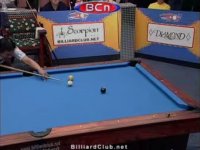I concede, I must be mistaken , Mikjary will send a PM
Have a great day
Sincerely: SS
Have a great day
Sincerely: SS
Some examples of Efren cueing low and applying follow to the cue ball. Notice the slight, almost imperceptible change in cue tip placement from address. His contact point is very close to a center ball hit despite having the cue ball showing follow from his stroke.
https://www.youtube.com/watch?v=oRvwlX3ihRg&feature=player_detailpage#t=397
https://www.youtube.com/watch?v=oRvwlX3ihRg&feature=player_detailpage#t=1693
https://www.youtube.com/watch?feature=player_detailpage&v=csQeR7p3X8o#t=3678
Best,
Mike

No way.
Try this,
Draw a circle.
Draw a line going from the center of the circle to the edge of the circle at a 45 degree upward angle.
Draw another line as before except with a 45 degree downward angle.
Where the line meets the outer edge of the circle is the the where the cue tip hits the CB.
I call this line the CB torque arm.
There is no way to hit below center and get roll.
Hitting below center causes the CB to rotate in a clockwise manner. For the CB to go forward requires the CB to rotate counter clockwise.
No way can you hit below center and have the CB rotate counter clockwise.
I'm a firm believer that a picture is worth a thousand words. Here is a drawing that reflects what I posted earlier describing what I cal the CB torque arm.
The arrows represents the cue stick and direction it is moving.
Thing about me is that I bring something to back up what I state. If you can hit below the center of the CB at a downward angle and have the CB rotate counter clockwise and not clock wise, you have just entered the Twilight Zone.
But then again you must have the capacity to understand this first.
And there are no objective points of aim......its all in your head......therefore subjective. There is no way to know if two CTE users are using the same visuals or the same edges of the balls, even though balls don't have edges, one of those pesky scientific thingies, kinda like goes along with thinking you can hit 1/2 a ball when that is impossible, except for in your minds eye, IE subjective.
I'm a firm believer that a picture is worth a thousand words. Here is a drawing that reflects what I posted earlier describing what I cal the CB torque arm.
The arrows represents the cue stick and direction it is moving.
Thing about me is that I bring something to back up what I state. If you can hit below the center of the CB at a downward angle and have the CB rotate counter clockwise and not clock wise, you have just entered the Twilight Zone.
But then again you must have the capacity to understand this first.
And there are no objective points of aim......its all in your head......therefore subjective. There is no way to know if two CTE users are using the same visuals or the same edges of the balls, even though balls don't have edges, one of those pesky scientific thingies, kinda like goes along with thinking you can hit 1/2 a ball when that is impossible, except for in your minds eye, IE subjective.
Greg,
Did SmoothStroke say he was hitting at a downward angle?
Best,
Rick
Cueing low? Looks like at the upper limit of high to me. Right about where the stripe would be on a striped ball.
View attachment 373626
He said he was hitting below center. Below center means that you take the angle of the cue straight through the center of the cb. Anthing below that line is below center, anything above that line is above center.
Now, if he was just referring to below the horizontal center line compared to the table, then yes, one can on some shots hit below that and get follow. But, that is not hitting below center of the cb.
The key part of the word, "upstroke" is, "up". Where did his stroke start and what type of reaction did he get from the cue ball?
Glad you noticed his tip was at the miscue limit...and without miscuing! Or is it better to first address the cue at the miscue upper limit and then try for a power stroke? Hmmm?
Best,
Mike
The key part of the word, "upstroke" is, "up". Where did his stroke start and what type of reaction did he get from the cue ball?
Glad you noticed his tip was at the miscue limit...and without miscuing! Or is it better to first address the cue at the miscue upper limit and then try for a power stroke? Hmmm?
Best,
Mike
Does your post answer my question that was directed to Greg?
For most, yes, for you, apparently not.
Hi MIke,
Would that not be sort of like TOI?
Increasing the margin for error in one direction?:wink:
Best,
Rick
Here is a pic of my cue laying on a table. According to Neil there is no way to use upstroke on a pool table. This means that there are no shooting positions that will allow for a cue to be inside the rails therefore allowing the butt to be lowered to touching the table.
Lets just take that 7 up to almost the corner left pocket. Now place the CB just pass the end of my stick, bout the same distance off the rail as the 7 in the pic.
Go ahead and tell the world Neil that no one can up stroke in that shooting position I just described using the pic.
The key part of the word, "upstroke" is, "up". Where did his stroke start and what type of reaction did he get from the cue ball?
Glad you noticed his tip was at the miscue limit...and without miscuing! Or is it better to first address the cue at the miscue upper limit and then try for a power stroke? Hmmm?
Best,
Mike
